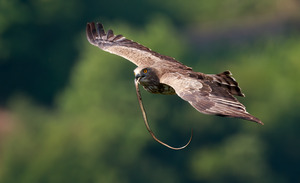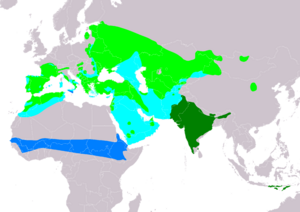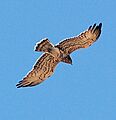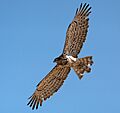Short-toed snake eagle facts for kids
Quick facts for kids Short-toed snake eagle |
|
|---|---|
 |
|
| In flight with prey - Trentino-South-Tyrol, Italy | |
| Conservation status | |
| Scientific classification | |
| Genus: |
Circaetus
|
| Species: |
gallicus
|
| Subspecies | |
|
|
 |
|
| Range of C. gallicus Breeding Resident Passage Non-breeding | |
The short-toed snake eagle (Circaetus gallicus) is a cool bird of prey. It's also known as the short-toed eagle. This medium-sized bird belongs to the Accipitridae family. This family includes many other birds of prey like kites, buzzards, and harriers. The name Circaetus comes from ancient Greek words meaning "hawk" and "eagle". The word gallicus means "from Gallia" (which is an old name for France).
Contents
What is a Short-Toed Snake Eagle?
The short-toed snake eagle is a type of eagle that loves to eat snakes! It's a powerful hunter with special features that help it catch its slithery prey.
How Big Are These Eagles?
These eagles are quite large. Adults are about 59 to 70 centimeters (23 to 28 inches) long. Their wings can spread out from 162 to 195 centimeters (about 5 to 6 feet) wide! They usually weigh between 1.2 and 2.3 kilograms (2.6 to 5.1 pounds). An average eagle weighs around 1.7 kilograms (3.7 pounds).
What Do They Look Like?
You can spot a short-toed snake eagle by its mostly white belly. Its upper body is a grayish-brown color. Its chin, throat, and upper chest are a light, earthy brown. The tail has 3 or 4 dark stripes. These eagles also have a round head, like an owl, bright yellow eyes, and light stripes under their wings.
How Do They Fly?
These eagles spend a lot of time flying high in the sky. They love to soar over hills using air currents, sometimes as high as 500 meters (1,640 feet)! They often hunt from this high position. When they fly over open areas, they might hover in one spot, just like a kestrel. When they soar, their wings stay mostly flat.
Where Do Short-Toed Snake Eagles Live?
This eagle species lives in many parts of the world. You can find them around the Mediterranean Sea, in Russia, the Middle East, parts of Western Asia, and in India. They also live on some islands in Indonesia.
Migration and Home Ranges
Eagles living in northern Europe and around the Mediterranean often migrate for winter. They fly south to sub-Saharan Africa (south of the equator). They usually leave in September or October and come back in April or May. However, eagles in the Middle and Far East stay in the same place all year round. In Europe, you'll see the most short-toed snake eagles in Spain. In other areas, they are quite rare.
What Kind of Places Do They Like?
Short-toed snake eagles prefer open areas like farms, dry, rocky scrublands, and semi-desert regions. They need trees to build their nests. They also need open spaces, like fields and grasslands, where they can hunt for food.
What Do Short-Toed Snake Eagles Eat?
These eagles mostly eat reptiles. Their favorite food is snakes, but they also eat lizards. Sometimes, they get into big fights with larger snakes on the ground! Occasionally, they might hunt small mammals, like rabbits, or even birds and large insects.
Life Cycle and Behavior
The short-toed snake eagle is usually a very quiet bird. Sometimes, it makes musical whistling sounds. When it's time to have babies, the female eagle lays only one egg. These eagles can live for up to 17 years.
Conservation and Protection
Sadly, the number of short-toed snake eagles in Europe has dropped a lot. They are now rare in many countries. This is happening because of changes in farming and how land is used. These eagles need our help to be protected! Luckily, in the middle and far eastern parts of their range, they are not yet in danger.
Gallery
-
In Kawal Wildlife Sanctuary, India













